Soil/Landform Unit 72
Landform Unit Description
Page top
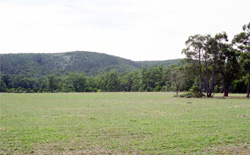 Exposed steeper south-western slopes of the dissected hills from recent fire. Grey and white sands are evident on the hillslope |
0.30% of CMA region The junction between Cretaceous and Paleogene sediments on the western periphery of the Otway Range is clearly reflected in vegetation changes. However, the junction is discontinuous and there is a belt of land where the higher parts of the landscape are capped by Paleogene sands with only occasional areas of silts and clays derived from Cretaceous sediments. The lower slopes are often steeper, with outcrops of Cretaceous sandstones and mudstones. Thus, the higher areas carry low woodlands of Eucalyptus nitida and E. baxteri, while the lower slopes support open forests or even tall open forests of E. obliqua and E. cypellocarpa. This landscape pattern is somewhat similar to soil-landform unit 66 in the Redwater Creek landsystem. The major distinguishing feature is that the position in the landscape at which the Cretaceous sediments outcrop is very variable. The deposit of sand above the Cretaceous sediments varies in thickness, but is usually deep enough for the native vegetation to be dependent upon the sand for its nutrient supply. Most parts of this unit remain uncleared and unused. Some sand and gravel extraction pits have been established in the past. Pines have been established on small areas adjoining privately held land. | 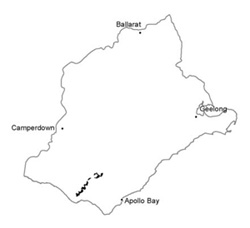 |
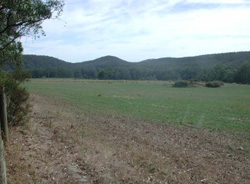 Cleared land near Chapple Vale currently being used for grazing | 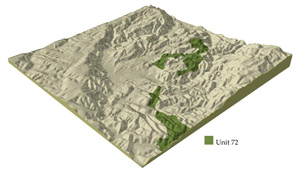 |
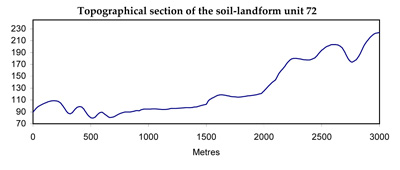 | 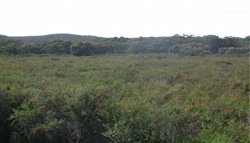 The higher areas carry low woodlands of Eucalyptus nitida and E. baxteri, while the lower slopes support open forests or even tall open forests of E. obliqua and E. cypellocarpa. |
Component | 1 | 2 | 3 | 4 | 5 |
Proportion of soil-landform unit | 30% | 5% | 20% | 30% | 15% |
| CLIMATE Rainfall (mm) | Rainfall (mm) Annual: 1100–1400, lowest January (55), highest August (150) | ||||
| Temperature (oC) | Temperature (oC) Annual: 12, lowest July (7), highest February (17) | ||||
| Seasonal growth limitations | Seasonal growth limitations Temperature: less than 10°C (av.) May–September Precipitation: less than potential evapotranspiration late November–mid March | ||||
| GEOLOGY Age and lithology | Paleogene unconsolidated marine sand, gravel, silt and clay. Cretaceous fluvio-volcanic mudstone, sandstone and conglomerate | ||||
| Geomorphology | |||||
| LANDUSE | Uncleared areas: Sand and gravel extraction; hardwood forestry for posts, poles, fuel and some sawlogson more fertile soils; nature conservation; water supply protection | ||||
| TOPOGRAPHY Landscape | Dissected hills with broad gentle hill cappings on western periphery of the Otway Range | ||||
| Elevation range (m) | 30–270 | ||||
| Local relief (m) | 75 | ||||
| Drainage pattern | Dendritic with some radial areas | ||||
| Drainage density (km/km2) | 2.6 | ||||
| Landform | Hills | ||||
| Landform element | Steep crest and slope | Drainage line | Lower slope | Crest and slope | Steep slope |
| Slope and range (%) | 15 (2–35) | 3 (0–5) | 9 (3–12) | 12 (2–25) | 30 (20–55) |
| Slope shape | Convex | Concave | Linear | Convex | Linear |
| NATIVE VEGETATION Structure | Low woodland | Closed scrub | Low open woodland | Open forest | Tall open forest |
| Dominant species | E. nitida, E. baxteri | Leptospermum juniperinum, Melaleuca squarrosa | E. baxteri, E. nitida | E. baxteri, E. obliqua, E. radiata, E. nitida | E. obliqua, E. cypellocarpa |
| SOIL Parent material | Quartz sand and gravel | Alluvial sand, plant remains | Quartz sand and gravel | Clay, silt, sand and gravel | In situ weathered mudstone, sandstone and conglomerate |
| Description (Corangamite Soil Group) | Grey sand soils (29) | Grey sand soils with hardpans (29) | Brown gradational soils (7) | ||
| Soil type sites | OTR742 | OTR609, OTR739, OTR740 | OTR414, OTR416, OTR748 | ||
| Surface texture | Loamy sand | Silty loam | Loamy sand | Sandy loam | Fine sandy clay loam |
| Permeability | Very high | High | Very low | High | Moderate |
| Depth (m) | >2 | >2 | 1.1 | >2 | 1.5 |
| LAND CHARACTERISTICS, POTENTIAL AND LIMITATIONS | Very low inherent fertility and high permeability lead to nutrient decline. Steeper slopes with compacted soils are prone to Sheet, rill and scour gully erosion. | High watertables lead to waterlogging. | Low inherent fertility and high permeability lead to nutrient decline. Weakly structured soils on steeper slopes are prone to sheet erosion. | Clay subsoils on steeper slopes subject to periodic saturation are prone to landslips. Soils of moderate permeability on steep slopes are prone to sheet erosion. | |


